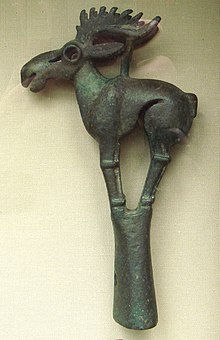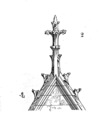Finial

Finial of the dome of the Taj Mahal

Bronze finial for a nomad's tent-pole, Ordos culture, 6th-5th century, Mongolia
A finial or hip-knob is an element marking the top or end of some object, often formed to be a decorative feature. In architecture it is a decorative device, typically carved in stone, employed to emphasize the apex of a dome, spire, tower, roof, or gable or any of various distinctive ornaments at the top, end, or corner of a building or structure. Where there are several such elements they may be called pinnacles. Smaller finials in materials such as metal or wood are used as a decorative ornament on the tops or ends of poles or rods such as tent-poles or curtain rods or any object such as a piece of furniture. These are frequently seen on top of bed posts or clocks. Decorative finials are also commonly used to fasten lampshades, and as an ornamental element at the end of the handles of souvenir spoons. The charm at the end of a pull chain (such as for a ceiling fan or a lamp) is also known as a finial.
During the various dynasties in China, a finial was worn on the top of the hats civil or military officials wore during formal court ceremonies. The finial was changed to a knob for other daily usage (including semi-formal ceremonies). The Pickelhaube is a Central European military helmet with a finial topped by a spike.
Contents
1 Roof
2 Flagpoles
3 Bed posts and curtain rods
4 Lamps and light fixtures
5 Gallery
6 See also
7 References
8 External links
Roof

a Balinese kemuncak on top of a thatched roof of a Balinese temple pavilion.
In Java and Bali, a rooftop finial is known as mustaka or kemuncak.
Flagpoles

French Imperial Eagle of a regiment of the Grande Armée
A "ball-style" finial is often mounted to the top of a stationary flagpole.[1] The United States Army, Navy, Marine Corps and Coast Guard employ a variety of different finials depending on the flag in question, the Marines and Coast Guard deferring to the Navy's protocols.[2]
Bed posts and curtain rods
Bed posts and public garden (park) railings often end in finials. Wooden posts tend to have turned wood finials.[3] While the purpose of finials on bed posts is mostly decorative, they serve a purpose on curtain rods, providing a way to keep a curtain from slipping off the end of a straight rod.[4]
Curtain rod finials can be seen to act much like a barometer of public taste. Many designs hark back to the Gothic and Neogothic of architectural finials, while other contemporary finials reflect minimalist, art nouveau and other traditional styles of décor. The use of different materials is as wide as the range of designs with brass, stainless steel, various woods and aluminium being employed with a variety of finishes such as ‘satin steel’ and 'antique brass'. The durability, strength and machinability of modern alloys have lent themselves to increasingly intricate and dazzling designs.
Lamps and light fixtures
Some lampshades or light fittings, especially in glass, typically terminate in a finial which also serves to affix the shade to the lamp or fixture. Finials are twisted onto the lamp harp. Typically the finial is externally decorative whilst hiding an internal screw thread. There are several standard thread sizes which are used.
Gallery

Stone finial at Aachen City Hall

Finial Illustration by Viollet-le-Duc, 1856

Finial shaped like a pineapple

Architectural decorations

Greek and Cypriot flags being flown on flagpoles with cross finials in front of a church, Pafos.
See also
- Acroterion
- Alem (finial)
- Crocket
- Souvenir spoon
Wikisource has original text related to this article: Floret |
References
^ Koppes, Wayne F.; Roehm, Jack M, eds. (1980). Metal Flagpole Manual. Chicago, Illinois: National Association of Architectural Metal Manufacturers. p. 21..mw-parser-output cite.citationfont-style:inherit.mw-parser-output .citation qquotes:"""""""'""'".mw-parser-output .citation .cs1-lock-free abackground:url("//upload.wikimedia.org/wikipedia/commons/thumb/6/65/Lock-green.svg/9px-Lock-green.svg.png")no-repeat;background-position:right .1em center.mw-parser-output .citation .cs1-lock-limited a,.mw-parser-output .citation .cs1-lock-registration abackground:url("//upload.wikimedia.org/wikipedia/commons/thumb/d/d6/Lock-gray-alt-2.svg/9px-Lock-gray-alt-2.svg.png")no-repeat;background-position:right .1em center.mw-parser-output .citation .cs1-lock-subscription abackground:url("//upload.wikimedia.org/wikipedia/commons/thumb/a/aa/Lock-red-alt-2.svg/9px-Lock-red-alt-2.svg.png")no-repeat;background-position:right .1em center.mw-parser-output .cs1-subscription,.mw-parser-output .cs1-registrationcolor:#555.mw-parser-output .cs1-subscription span,.mw-parser-output .cs1-registration spanborder-bottom:1px dotted;cursor:help.mw-parser-output .cs1-ws-icon abackground:url("//upload.wikimedia.org/wikipedia/commons/thumb/4/4c/Wikisource-logo.svg/12px-Wikisource-logo.svg.png")no-repeat;background-position:right .1em center.mw-parser-output code.cs1-codecolor:inherit;background:inherit;border:inherit;padding:inherit.mw-parser-output .cs1-hidden-errordisplay:none;font-size:100%.mw-parser-output .cs1-visible-errorfont-size:100%.mw-parser-output .cs1-maintdisplay:none;color:#33aa33;margin-left:0.3em.mw-parser-output .cs1-subscription,.mw-parser-output .cs1-registration,.mw-parser-output .cs1-formatfont-size:95%.mw-parser-output .cs1-kern-left,.mw-parser-output .cs1-kern-wl-leftpadding-left:0.2em.mw-parser-output .cs1-kern-right,.mw-parser-output .cs1-kern-wl-rightpadding-right:0.2em
^ Army Regulation 840-10 Flags, Guidons, Streamers, Tabards, and Automobile and Aircraft Plates, Chapter 8 "Flagstaffs and Flagstaff Heads (Finials)", § 8-2, 1 November 1998 Archived 7 June 2010 at the Wayback Machine
^ google search - bed post finials. Retrieved 2014-07-27.
^ google search - curtain rod finials. Retrieved 2014-07-27.
External links
| Wikimedia Commons has media related to Finials. |
- Word-of-the-day on finial





